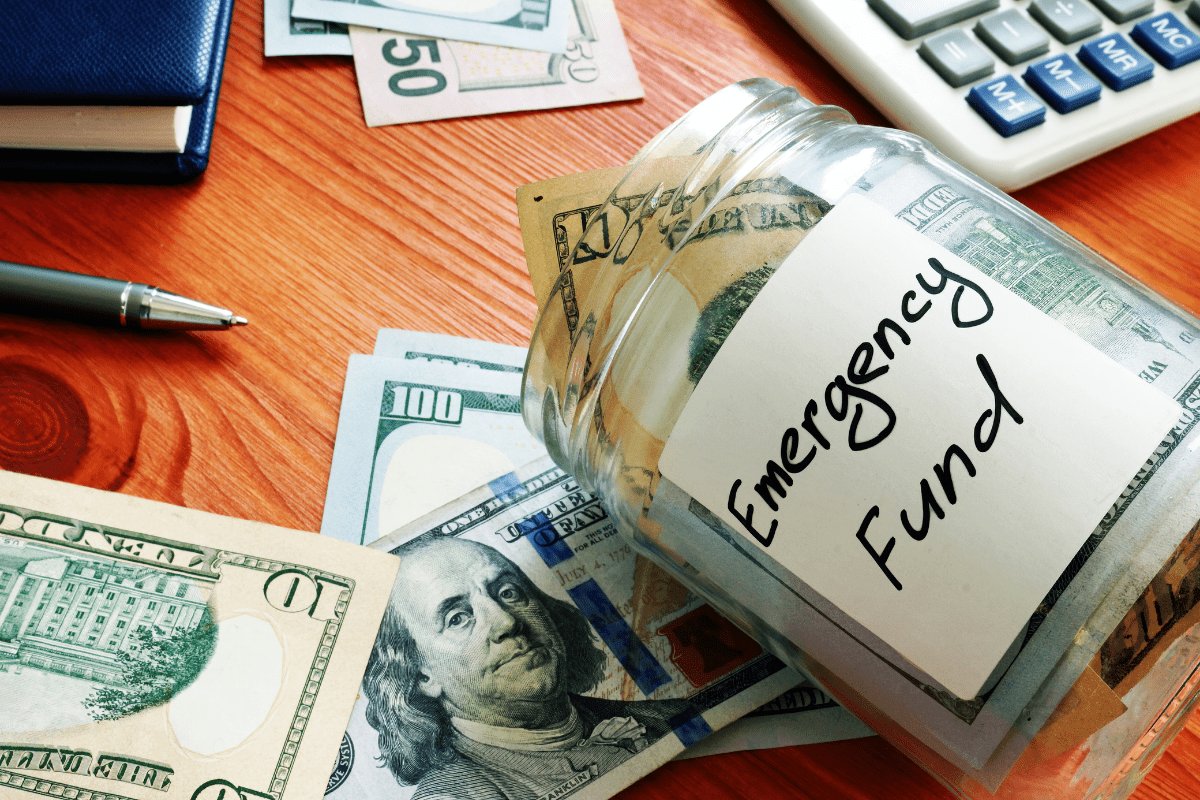Ever had your car make that ominous clunk right after payday, when your checking account is leaner than a supermodel on a juice fast? Yeah, us too. That is why building an emergency fund isn’t just adulting—it’s survival on hard mode. Welcome, friends, to our guide on stockpiling cash so those plot twists don’t turn into full-blown tragedies.
Why you absolutely, positively need an emergency fund
An emergency fund is the financial equivalent of a seat belt. It sits quietly until life slams on the brakes. According to the latest Bankrate survey, 59% of Americans couldn’t handle a $1,000 surprise right now, which means most of us are one rogue pothole away from a debt spiral.
Unexpected expenses don’t file a polite calendar invite. A leaky roof, a surprise vet bill, or a sudden layoff can land harder than your ex’s new relationship announcement. Money you stash beforehand cushions the fall, letting us pay bills with cash instead of frantic credit-card swiping.
Psychologically, having even a small buffer lowers stress. Studies on financial anxiety show that people with liquid savings sleep better, argue less about money, and feel more in control of their lives. Cash in reserve lets us negotiate better, job-hunt smarter, and skip predatory loans that charge interest faster than a toddler inhales cookies.
An emergency fund also prevents “investment sabotage.” Selling index funds in a downturn to cover rent means locking in losses. Cash lets investments ride out volatility. In short, the fund is the wall separating routine life from full-blown chaos.
Finally, consider opportunity cost. Emergencies cost more when we’re broke because late fees, higher insurance deductibles, and interest pile up. Paying cash avoids those drainers. We’re not dodging fate; we’re buying time and peace of mind at a discount.
Deciding how much cash is enough
Traditional advice yells “three to six months of living expenses.” Great, except what does that even look like for our unique hot mess of bills? Start by tallying the non-negotiables: rent or mortgage, utilities, groceries, insurance, minimum debt payments, and any medication Fido requires to remain among the living. Multiply that by however many months help you sleep at night.
Risk profile matters. Freelancers riding the feast-or-famine roller coaster need more padding than a tenured professor with ironclad job security. Dual-income households can sometimes aim lower because one paycheck might still flow if the other dries up. Conversely, single earners with dependents may want a solid six months or more.
Look at industry volatility. Tech startup? Build at least half a year’s cushion because pink slips drop faster than new AI buzzwords. Government gig? You might slide by with three months if you’re comfortable. Health status also counts. Chronic medical conditions mean higher surprise costs, so tilt the fund upward.
Remember inflation. Groceries don’t care about your spreadsheet—they care about global supply chains. Pad your number by 10% to account for price creep and the occasional latte that sneaks in.
Round your final figure to something memorable—say, $15,000 instead of $14,732. Psychological round numbers are easier to track. Celebrate incremental milestones: first $500, first month covered, first $5,000. The brain loves progress bars.
The key is committing to a number now and adjusting annually. Perfect is the sworn enemy of started. Estimate, aim, fire—then calibrate.
Finding the money without selling a kidney
Spoiler: magical Uncle Moneybags isn’t showing up. That leaves trimming spending, boosting income, or—ideally—both. Start by stalking our bank statements like it’s a true-crime documentary. Recurring charges for unused apps, ghost-gym memberships, and that streaming service we forgot after the season finale ended? Cancel them. Redirect the freed-up dollars straight to the emergency fund before they mingle with discretionary spending and disappear.
Next, attack lifestyle inflation. If every pay raise morphs into a nicer coffee habit, we’re doing capitalism wrong. Earmark a percentage of each bump—say, half—for savings, and let the rest upgrade life in small ways. Side hustles also accelerate progress. Driving rideshare on weekends, tutoring online, or selling those impulse-buy collectibles lurking in the closet can funnel fresh cash into the fund faster than austerity alone.
Finally, gamify the process. Challenge friends to “no-spend” weekends, funnel every $5 bill we touch into a jar, or set up automatic transfers that coincide with paydays so we never see the money lingering in checking, flirting with impulse. Momentum matters more than perfection; a steady drip fills the bucket.
Choosing the perfect parking spot for your stash
Your emergency fund needs to be Goldilocks accessible. Not locked up like a 401(k), but not so close you’ll blow it on concert tickets. Enter the high-yield savings account.
Online banks routinely pay five to ten times traditional brick-and-mortar interest. That tiny percentage difference sounds meh until you realize $10,000 at 4.5% earns $450 a year for doing absolutely nothing—like passive income’s lazy cousin.
Look for FDIC insurance, no monthly fees, and same-day or next-day transfers. Money market accounts are also viable, but watch for minimum balance requirements and withdrawal limits.
Avoid chasing yield into risky territory. A certificate of deposit with early withdrawal penalties defeats the purpose. And crypto wallets? Volatile assets make terrible umbrellas in downpours.
Keep the account separate from your daily spending hub. Psychologically, the extra login step or 24-hour transfer delay adds friction, discouraging impulsive raids. Label the account “Hands Off” or “Future Me’s Lifeboat.” Corny, but effective.
Some folks split funds: one micro-fund of $1,000 in a checking account for ultra emergencies, the rest in higher-yield savings. This hybrid approach balances instant access with better returns. Test what lets you sleep.
Finally, check the bank’s transfer limits. Large withdrawals during a medical emergency shouldn’t require a carrier pigeon. Read the fine print before trusting them with your rainy-day lifeline.
Automating the saving so the money fairy does the heavy lifting
Human willpower is squishier than overripe avocados. Automate contributions the moment income hits. Schedule an automatic transfer for payday plus one. Money that bypasses checking accounts avoids accidental spending.
Many employers let us split direct deposits between multiple accounts. Allocate, say, 10% of net pay straight into the emergency fund. Out of sight equals out of temptation.
Use percentage-based transfers rather than flat dollar amounts when income fluctuates. Gig workers can stash 20% of every invoice. Big month? Bigger savings. Lean month? Still proportional.
Incremental increases add up. Boost contributions by 1% every quarter. Barely noticeable in daily living yet significant over time. Set calendar reminders or, better, automate step-ups if your bank supports them.
Windfall rule: at least 50% of bonuses, raises, or refunds goes directly into the fund. Celebrate lifestyle inflation with the other half guilt-free. Win-win.
Track progress visually. A simple bar chart in your budgeting app or a colored thermometer stuck to the fridge lights up dopamine receptors. Watching the bar grow keeps motivation sizzling long after the novelty fades.
Defining what counts as a real emergency
Pro tip: concert tickets going on sale is not a crisis. Qualified emergencies threaten health, housing, income, or basic transportation. Medical bills? Yes. Impulse Bahamas getaway? No, unless our boss just mandated a surprise presentation on that beach. The clearer the definition, the easier it is to resist withdrawals that sabotage the fund.
Create a written “approval checklist.” If the expense is unexpected, necessary, and time-sensitive, the fund opens its doors. If it fails any criterion, look elsewhere. Pair this with a 24-hour cooling-off rule. Many “emergencies” reveal themselves as wants masquerading in panic clothing once we sleep on them.
When we do dip in, document the reason and draft a payback plan. That accountability maintains fund integrity and turns withdrawals into temporary loans rather than permanent surrenders. Then review patterns annually—if car repairs keep raiding the fund, maybe it’s time to upgrade the jalopy or budget more for maintenance. Adjusting the root causes keeps the fund from becoming a revolving door.
Maintaining and growing the buffer over time
The world changes, and so should our safety net. Inflate the target with inflation—price hikes don’t politely pause during crises. Recalculate essentials annually, and bump the fund accordingly. Life milestones count, too. New baby? Bigger apartment? Freelance leap? Each demands a thicker cushion.
Once the emergency fund is comfortably full, redirect those automated contributions toward other goals—retirement, a home down payment, or that trip we responsibly postponed earlier. Keep at least minimal funding flowing, though, to offset withdrawals and inflation creep.
We can also explore tiered security: the first three months in ultra-liquid savings, the next three in short-term CDs, and anything beyond six months in conservative bond funds. That structure balances access and growth without jeopardizing peace of mind.
Review accounts for competitive yields and fees. Loyalty is lovely in friendships, not in banking. A 0.5-percentage-point better rate on $15,000 earns roughly $75 extra per year for about five minutes of form-filling. That’s a solid hourly wage for clicking buttons.
Finally, share the wisdom. Teaching friends or family solidifies our habits. Just 24% of Americans have zero emergency savings, according to Bankrate’s 2025 report. Peer encouragement nudges that stat down while boosting everyone’s resilience.
Building and guarding an emergency fund isn’t glamorous, but it turns chaos into inconvenience. And when the next plot twist arrives—because it will—we’ll be too busy calmly writing checks to notice the drama.




